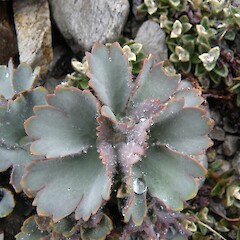Ranunculus pilifera
Synonyms
Ranunculus haastii subsp. piliferus F.J.F.Fisher
Family
Ranunculaceae
Flora category
Vascular – Native
Endemic taxon
Yes
Endemic genus
No
Endemic family
No
Structural class
Herbs - Dicotyledons other than Composites
NVS code
The National Vegetation Survey (NVS) Databank is a physical archive and electronic databank containing records of over 94,000 vegetation survey plots - including data from over 19,000 permanent plots. NVS maintains a standard set of species code abbreviations that correspond to standard scientific plant names from the Ngä Tipu o Aotearoa - New Zealand Plants database.
RANPIL
Chromosome number
2n = 48
Current conservation status
The conservation status of all known New Zealand vascular plant taxa at the rank of species and below were reassessed in 2017 using the New Zealand Threat Classification System (NZTCS) – more information about this can be found on the NZTCS website. This report includes a statistical summary and brief notes on changes since 2012 and replaces all previous NZTCS lists for vascular plants.
Please note, threat classifications are often suggested by authors when publications fall between NZTCS assessment periods – an interim threat classification status has not been assessed by the NZTCS panel.
- Conservation status of New Zealand indigenous vascular plants, 2017 . 2018. Peter J. de Lange, Jeremy R. Rolfe, John W. Barkla, Shannel P. Courtney, Paul D. Champion, Leon R. Perrie, Sarah M. Beadel, Kerry A. Ford, Ilse Breitwieser, Ines Schönberger, Rowan Hindmarsh-Walls, Peter B. Heenan and Kate Ladley. Department of Conservation. Source: NZTCS and licensed by DOC for reuse under the Creative Commons Attribution 4.0 International licence.
2017 | At Risk – Declining | Qualifiers: DP, RR, RF
Previous conservation statuses
2012 | At Risk – Declining | Qualifiers: DP
2009 | At Risk – Declining | Qualifiers: DP
2004 | Range Restricted
Distribution
Endemic. South Island. West Otago (Hector Mountains) and Southland (Eyre, Thomson and Takitimu Mountains, also East Dome).
Habitat
High alpine occupying sparsely vegetated rock-slides and rock-fields derived from greywacke and non-foliated schist.
Detailed description
Robust, summer-green, rhizomatous herb up to 400 mm high, forming dense patches up to 1 m across. Rhizomes numerous, stout, fleshy, 10-12 mm diameter, regularly branched, covered with the remains of sheathing petiole bases and vascular strands, with numerous long fleshy roots 2-5 mm diameter; bud scales up to 40 mm long, clasping scape and petiole, abaxial surface moderately to densely covered with pilose hairs, adaxial surface sparsely hairy to glabriate near distal part and glabrous on proximal part. Lamina 60-75 x 75-130 mm, broadly reniform or broadly orbicular in outline, subcoriaceous, adaxial surface grey or grey-green with abaxial surface paler, both surfaces sparsely pilose hairy, glabrate (rarely glabrous), moderately hairy at insertion of petiole, proximal part distinctly veined, divided into 3 primary segments, occasionally further subdivided toward base; segments weakly dissected, with few, oblong to broadly oblong, overlapping lobes, further subdivided into smaller segments with oblong to broadly oblong lobes up to 5-30 mm deep, usually planar or slightly upwardly curved near margin; margin crenate, lobes usually wider than long or of similar width and length, teeth 2-9 mm long, broadly obovate, oblong to broadly oblong, apices obtuse, margin red; petiole 50-250 x 5-9 mm, fleshy, terete; sheath 15-40 mm long, moderately to densely covered with pilose hairs. Scape 80-400 x 5-14 mm, yellow-green or green, basally flushed red, terete with 1-6 flowers, each flower subtended by a leafy bract. Bracts similar to leaves, sessile, smaller toward distal flowers. Peduncles sparsely to moderately hairy, particularly near distal part. Flowers 40-50 mm diameter. Receptacle conical, 9.7-10.0 x 3/5-6.6 mm, often sparsely hairy and with a fringe of retrorse hairs at base, sometimes glabrous. Sepals 4-6, 20-22 x 8-11 mm, yellow-green to light green, oblong, oblong-elliptic or broadly elliptic, sometimes saccate, usually hairy on both surfaces, apex obtuse, often praemorse; nectary a simple pit. Stamens 110-139. glabrous; anthers 1.8-2.8 mm long, cream; filament 1.6-8.5 x 0.7-1.4 mm, translucent, distally tapered. Carpels 126-171 x 4.7-6.1 mm, glabrous or with a small tuft of hairs at base; stigma with minute papillae. Achenes 6.4-7.3 x 2.7-3.4 mm; body obovate, 1.8-2.5 x 1.3-1.7 mm, yellow-brown, surrounded by a wing 0.9-1.0 mm wide; beak curved to ventral side, laterally compressed, tapering toward a point at apex.
Similar taxa
Closest to R. acraeus Heenan et P.J.Lockhart from which it is distinguished by its weakly dissected, coarsely crenate rather than finely crenate leaf and bract margins, hairy rather than glabrous peduncle; by the 4-5(-6) hairy rather than only abaxially hairy sepals, and allopatric distribution. From R. haastii Hook.f. it differs by its much less divided, pilose-hairy rather than glabrous leaves, and allopatric distribution.
Flowering
November - January
Flower colours
Green, Yellow
Fruiting
December - February
Propagation technique
Difficult. Should not be removed from the wild
Threats
An uncommon species common at sites within its small geographic area.
Etymology
ranunculus: From the Latin ‘rana’ frog, meaning little frog and probably refers to the plants typical marshy habit where frogs abound
pilifera: Hair-bearing; having soft short hairs
Where To Buy
Not commercially available
Notes on taxonomy
Ranunculus piliferus is further distinguished from both R. haastii and R. acraeus by its different nrDNA ITS and cpDNA sequences (see Heenan et al. (2006)).
Attribution
Fact Sheet prepared for NZPCN by P.J. de Lange (30 October 2008). Description by P.B. Heenan based on Heenan et al. (2006).
References and further reading
Heenan, P.B; Lockhart, P.J.; Kirkham, N.; McBreen, K.; Habell, D. 2006: Relationships in the alpine Ranunculus haastii (Ranunculaceae) complex and recognition of R. piliferus and R.acraeus from southern New Zealand. New Zealand Journal of Botany 44(4): 425-441.
NZPCN Fact Sheet citation
Please cite as: de Lange, P.J. (Year at time of access): Ranunculus pilifera Fact Sheet (content continuously updated). New Zealand Plant Conservation Network. https://www.nzpcn.org.nz/flora/species/ranunculus-pilifera/ (Date website was queried)




